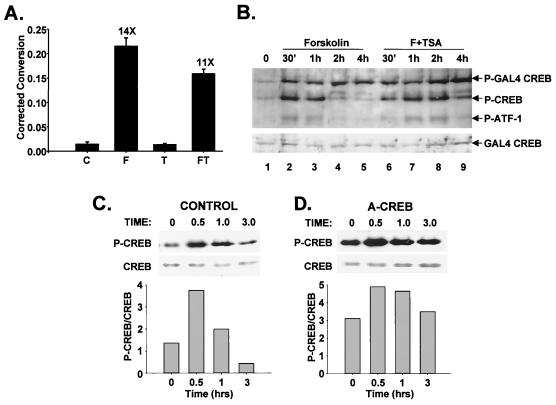FIG. 5.
Persistent activation of non-chromatin-bound CREB polypeptides following stimulation with cAMP agonist suggests a chromatin-dependent mechanism for transcriptional attenuation. (A) HDAC inhibitors have no effect on cAMP-dependent induction of a nonchromosomal somatostatin gene in D5 cells. The bar graph shows CAT activity derived from a somatostatin promoter construct after normalizing to activity from cotransfected RSV-βGAL plasmid. Cells were stimulated with forskolin (F) and/or TSA (T), as indicated, for 4 h prior to harvesting. C, control. (B) Western blot assay of whole-cell extracts from D5 cells transfected with a GAL4-CREB(1-283) construct containing the GAL4 DNA binding domain but lacking the leucine zipper/DNA binding domain of CREB. At least 50% of cells were transfected, according to fluorescence from a cotransfected RSV-GFP expression vector. Cells were treated with forskolin alone or forskolin plus TSA (F+TSA) for times indicated, and levels of phospho-Ser133 CREB and phospho-Ser133 GAL-CREB(1-283) were evaluated by Western blot assay with phospho-Ser133-specific antiserum 5322. A Western blot with GAL4 antiserum to visualize total levels of GAL4-CREB in transfected cells is shown below. (C and D) Overexpression of dominant negative A-CREB polypeptide enhances phosphorylation of CREB in D5 cells stimulated with forskolin. Results show Western blot assay of D5 cells transfected with either A-fos (control) or A-CREB expression vector plus CMV-GFP fluorescence marker and then FACS sorted. A-fos- and A-CREB-expressing cells were stimulated for various times with forskolin, and whole-cell extracts were analyzed by Western blot assay with phospho-Ser133-specific antiserum or with nondiscriminating CREB antiserum (244). The bar graphs show ratio of phospho-CREB to total CREB at each time point, as estimated by densitometry.

